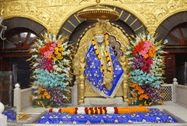In the heart of India, nestled amidst the sacred lands of Ayodhya in the state of Uttar Pradesh, lies a place that resonates with the echoes of ancient tales and fervent devotion – the Ayodhya Ram Mandir, also known as Sri Ram Janmabhoomi Temple. This revered shrine, dedicated to Lord Rama, embodies a timeless saga of faith, heritage, and the indomitable spirit of millions.
A Tapestry of Mythology and History:
Ayodhya, often hailed as the birthplace of Lord Rama, holds a significant place in Hindu mythology. According to the epic Ramayana, Ayodhya was the capital of the illustrious kingdom of Kosala, ruled by the virtuous King Dasharatha. It was here that Lord Rama, the seventh avatar of Lord Vishnu, incarnated as the embodiment of righteousness and virtue.
The narrative of Ayodhya is intertwined with the epic journey of Lord Rama, his exile to the forests, the abduction of his consort Sita by the demon king Ravana, and the eventual triumph of good over evil in the form of the epic battle of Ramayana. The rich tapestry of Ayodhya’s history is replete with tales of valor, sacrifice, and divine intervention.
The Ayodhya Dispute:
In modern times, Ayodhya became embroiled in a protracted legal and political controversy known as the Ayodhya dispute. The dispute centered around a plot of land in Ayodhya, where the Babri Masjid, a mosque built by the Mughal emperor Babur in the 16th century, stood.
Legend has it that the mosque was constructed on the site believed to be the birthplace of Lord Rama, where a temple dedicated to him once stood. The dispute sparked communal tensions and became a flashpoint for religious and political discord in India.
A Landmark Legal Battle:
For decades, the Ayodhya dispute remained a contentious issue, with multiple legal battles fought over the ownership of the disputed site. The case witnessed fervent arguments from both Hindu and Muslim groups, each claiming rights to the land.
The legal saga culminated in a landmark judgment by the Supreme Court of India in November 2019, which ruled in favor of the construction of a Hindu temple at the site. The court also directed the government to allocate an alternative piece of land to the Muslim community for the construction of a mosque, aiming to foster communal harmony and uphold the principles of secularism.
A Symbol of Unity and Faith:
The verdict of the Supreme Court paved the way for the construction of the Ayodhya Ram Mandir, marking a significant milestone in the history of India. The groundbreaking ceremony for the temple took place on August 5, 2020, with Prime Minister Narendra Modi laying the foundation stone amid elaborate rituals and festivities.
The construction of the temple is a testament to the unwavering faith and collective aspirations of millions of Hindus across the globe. It symbolizes the triumph of truth, justice, and the spirit of resilience in the face of adversity. The Ayodhya Ram Mandir is not merely a place of worship but a symbol of unity, inclusivity, and the shared cultural heritage of India.
A Magnificent Architectural Marvel:
The Ayodhya Ram Mandir is envisioned to be a grand architectural marvel, showcasing the rich heritage and cultural legacy of India. The temple’s design draws inspiration from traditional Indian architecture, with intricate carvings, majestic spires, and ornate sculptures depicting scenes from the Ramayana.
The temple complex will encompass sprawling courtyards, serene meditation halls, and lush gardens, offering devotees a tranquil space for spiritual contemplation and reflection. The sanctum sanctorum will house the sacred idol of Lord Rama, adorned with precious jewels and exquisite craftsmanship, radiating divine grace and splendor.
A Pilgrimage of Devotion and Reverence:
For millions of devotees, the Ayodhya Ram Mandir is more than just a place of worship; it is a sacred pilgrimage destination that holds profound spiritual significance. Pilgrims from across the country and beyond undertake arduous journeys to pay homage to Lord Rama and seek his blessings at his divine abode.
The temple’s completion is eagerly awaited by devotees worldwide, who fervently anticipate the opportunity to offer prayers and participate in the rituals and festivities that will accompany its inauguration. The Ayodhya Ram Mandir is destined to emerge as a beacon of spiritual enlightenment and a symbol of faith that transcends boundaries of caste, creed, and nationality.
Conclusion:
The Ayodhya Ram Mandir stands as a testament to the enduring legacy of Lord Rama and the timeless values of righteousness, compassion, and dharma that he embodies. It epitomizes the spirit of resilience, unity, and communal harmony that defines the cultural ethos of India.
As the temple nears completion, it heralds a new era of hope, renewal, and spiritual revival, beckoning devotees to embark on a journey of inner transformation and self-discovery. The Ayodhya Ram Mandir is not merely a physical edifice but a sacred sanctuary that encapsulates the eternal essence of divinity, beckoning humanity to tread the path of righteousness and virtue.
In the hallowed precincts of Ayodhya, amidst the whispers of ancient hymns and the fragrance of incense, the Ayodhya Ram Mandir stands as a timeless testimony to the eternal bond between humanity and the divine, inspiring generations to embrace the path of truth, love, and spiritual enlightenment.






